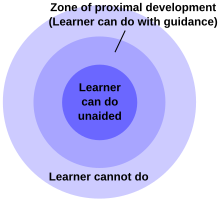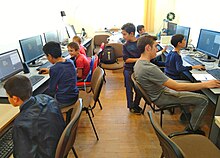User:TeachTESOL/English-language learner
| This is the sandbox page where you will draft your initial Wikipedia contribution.
If you're starting a new article, you can develop it here until it's ready to go live. If you're working on improvements to an existing article, copy only one section at a time of the article to this sandbox to work on, and be sure to use an edit summary linking to the article you copied from. Do not copy over the entire article. You can find additional instructions here. Remember to save your work regularly using the "Publish page" button. (It just means 'save'; it will still be in the sandbox.) You can add bold formatting to your additions to differentiate them from existing content. |
Issues in schools[edit][edit]

The federal No Child Left Behind Act (NCLB) requires all ELLs attending public schools from grades K-12 to be assessed in multiple language domains, such as listening, reading, writing, and speaking. The NCLB Act also requires ELL students to partake in statewide standardized testing. However, there is an achievement gap between ELLs and their native English-speaking peers. This achievement gap persists not only in language-based disciplines, but also in the math, science, and social science subjects. Research in this area suggests that ELL students' content-based assessment outcomes might be confounded by language barriers, since they are not only being exposed to new material, but they are learning this new material in a language that they may still be gaining proficiency in.
Models of Instruction[edit]
There are a wide variety of different program models that may be used to structure the education of English language learners (ELLs). These program models vary depending on the goals of the program and the resources available. Some researchers describe program models as existing on a spectrum from more monolingual forms to more bilingual forms.[1] Others distinguish between English-only program models and bilingual program models.[2]

Fast-track to English programs encourage students to use English as quickly as possible and offer little to no native language support. In transition-bilingual programs, instruction begins in the student's native language and then switches to English in elementary or middle school. In dual language programs (also known as two-way bilingual or two-way immersion programs), students become fluent simultaneously in their native language and English. [3] Sheltered instruction is another approach in which integrates language and content instruction in the mainstream classroom environment.[4] Program models utilizing sheltered instruction may also be referred to as content-based instruction (CBI) or content language integrated learning (CLIL).[5]
"Push-in" programs versus "Pull-out" programs[edit]
Two specific models of instruction include the push-in program and the pull-out program. The push-in program includes the English teacher coming into the classroom to aid the English Language Learner. The benefit of this method is that students remain integrated in the classroom with their native English-speaking peers. This method does not isolate or single out ELL students; However, this method can present challenges in co-teaching, as the educators must work together to collaborate in the classroom. [6] In schools using a push-in style of teaching, educators disagree over whether ELL students should be encouraged or permitted to participate in additional foreign language classes, such as French. Some educators argue that learning another additional language while learning English might be too challenging for ELLs, or that ELLs should focus on their English proficiency before attempting further languages. Other educators insist that foreign language classes are the only classes that put ELL students on a level playing field with their peers, and furthermore that research may suggest that ELL students perform better in foreign language classes than their peers.[7]
The push-out program entails the ELL student learning in a separate classroom with the English teacher. The benefit of such a method is that ELL students receive individualized, focused training. Unfortunately, this method can isolate ELL students from the rest of their peers, leaving them feeling left out from the community.[8]
Instructional Practices[edit]
***(add intro about instructional practices)
In a five-week study by J. Huang, research showed that "classroom instruction appeared to play an important role in integrating language skills development and academic content learning." This study also highlighted that the "students acquire linguistic/literacy skills and scientific knowledge hand in hand as they assume various communicative and social roles within carefully planned language activities."[9] By tying scientific content in English, the students were able to improve their language development between drafts and build upon their existing knowledge of scientific content as well.
Scaffolding[edit]

Scaffolding theory was introduced in 1976 by Jerome Bruner, David Wood, and Gail Ross.[10] Bruner adapts Lev Vygotsky’s zone of proximal development theory to child development. In the context of aiding ELL students, scaffolding is seen as a way to offer more support to ELL students initially through additional strategies and approaches, which are gradually removed as the student gains independence and proficiency. Different scaffolding strategies include associating English vocabulary to visuals, drawing back to a student’s prior knowledge, pre-teaching difficult vocabulary before assigning readings they appear in, and encouraging questions from students, whether they be content-related or to ensure comprehension. All of these additional areas of support are to be gradually removed, so that students become more independent, even if that means no longer needing some of these associations or seeking them out for themselves.
Labor-Based Grading[edit]
In Asao Inoue's work "Labor-Based Grading Contracts," he proposes an alternative to traditional content-based or quality-based methods of assessment in writing classrooms.[11] Inoue outlines his own innovative classroom design, which assigns grades based on set standards for how much work is put into each assignment through quantitative methods such as word counts. High marks are earned by students who go above the baseline requirements, which earn students a "B" on the A-F grading scale. The intent behind Inoue's design is that students are rewarded for their efforts rather than deterred, and students who traditionally score poorly when graded on quality (such as ELL students) are equally capable of receiving a certain grade as any other student, despite any educational setbacks or challenges they endure. A unique aspect to the labor-based grading design is that students collaborate as a class to decide what the terms on conditions of grading scales are. This way, all student's voices are heard and considered when developing a method of evaluation for their work.
Enriching the Classroom Environment[edit][edit]
In order to maintain an environment that is beneficial for both the teacher and the student, culture, literature, and other disciplines should be integrated systematically into the instruction. Postponing content-area instruction until CLD students gain academic language skills bridges the linguistic achievement gap between the learners and their native-English speaking peers. Relating to culture, teachers need to integrate it into the lesson, in order for the students to feel a sense of appreciation and a feeling of self-worth rather than ostracization. When working with English language learners, it is suggested that teachers try to understand the cultural background of their students in relation to education. What might be incorrect in English, might be correct in one’s native language. If this is the case, then the student may transfer information from his/her first language to the second[12]. Students will benefit substantially from the use of literature in instruction, as well. "Reading texts that match learner interests and English proficiency provide learners with comprehensible language input—a chance to learn new vocabulary in context and to see the syntax of the language." Students can also gain additional motivation and enjoyment from the addition of literature. Students also can gain motivation in writing by teachers allowing them to write about culturally relevant topics that allow students to express where they come from and aspects of their culture [12]. By integrating other disciplines into the lesson, it will make the content more significant to the learners and will create higher order thinking skills across the areas. Introducing language in other contexts focuses not only on learning a second language, but using that language as a medium to learn mathematics, science, social studies, or other academic subjects. These varying approaches aid ELL students' awareness "that English is not just an object of academic interest nor merely a key to passing an examination; instead, English becomes a real means of interaction and sharing among people". Therefore, students will be able to communicate across the curriculum, acquire higher level skills, and be successful in their daily lives.
Strategies for Supporting English-Language Learners in the Classroom and Beyond[edit]
Allowing students to translanguage, or alternate, between English and their native language is an essential strategy for English language learners. In the classroom, English language learners can often feel intimidated when asked to speak, so when students are allowed to use their first language to help produce their second language, it lessens some of the anxiety that can occur[13]. Often times in the classroom, teachers ask students to communicate complex ideas and translanguing helps students do this. In this case, teachers are not concerned so much about their language output, but rather if they are able to communicate their ideas[14]. By allowing students to translanguage in the classroom, it allows students to process and convey their ideas in a lower-risk output situation (worksheets) that can lead to more high-risk output situations (essays and projects)[14].
When it comes to writing, constant and a variety of feedback needs to be given. This could be about syntax or sentence structures, which feedback could be given on a rubric[12]. Modeling effective writing is also an essential strategy, which can be done by vocalizing their reasoning for choice in vocabulary, sentence structure, and even purpose for writing[12]. Teachers should chunk writing steps into manageable sections for English language learners[12].
Incorporating technology is one strategy for supporting English-Language Learners in the classroom. The internet makes it possible for students to view videos of activities, events, and places around the world instantaneously. Viewing these activities can help English-Language Learners develop an understanding of new concepts while at the same time building topic related schema (background knowledge). Introducing students to media literacy and accessible materials can also aid them in their future academic endeavors and establish research skills early on. This can also help students visually as well. For English language learners, listening all the time can become very taxing, so teachers should add in visual as much as they can to support students[13]. Technology allows teachers to do this because images can be projected on the screen as well as text when learning new concepts.

Experiential learning is another strategy to support ELL students. The teacher can provide opportunities for English Language Learners to acquire vocabulary and build knowledge through hands-on learning. This can include activities such as science experiments and art projects, which are tactile ways that encourage students to create solutions to proposed problems or tasks.
A strategy that requires more involvement from educators is supporting the students outside of the school setting. To respond to deficiencies in the public school system, educators and student activists have created spaces that work to uplift ELL and their families. Labeled as family-school-community partnerships, these spaces have sought out cultural and linguistic responsiveness through encouraging participation and addressing needs outside of school. It is an interpretation of growth through art and community bonding meant to prime student development.
References[edit]
Elfers, A. M., & Stritikus, T. (2014). How School and District Leaders Support Classroom Teachers’ Work With English Language Learners. Educational Administration Quarterly, 50(2), 305–344. https://doi.org/10.1177/0013161X13492797
Keengwe, J., & Onchwari, G. (2019). Handbook of research on assessment practices and pedagogical models for immigrant students . Information Science Reference.
Maxwell, L. A. (2014). Different ELL Programs Found Effective; “Differences in Instructional Models in English Learners’ Academic and English Proficiency Trajectories.” Education Week, 33(26), 5–5.
Pea, R. D. (2004). The Social and Technological Dimensions of Scaffolding and Related Theoretical Concepts for Learning, Education, and Human Activity. The Journal of the Learning Sciences, 13(3), 423–451. https://doi.org/10.1207/s15327809jls1303_6
Polat, N., & Cepik, S. (2016). An Exploratory Factor Analysis of the Sheltered Instruction Observation Protocol as an Evaluation Tool to Measure Teaching Effectiveness. TESOL Quarterly, 50(4), 817–843. https://doi.org/10.1002/tesq.248
Whiting, J. (2017). Caught Between the Push and the Pull: ELL Teachers’ Perceptions of Mainstreaming and ESOL Classroom Teaching. NABE Journal of Research and Practice, 8(1), 9–27. https://doi.org/10.1080/26390043.2017.12067793
http://www.nysed.gov/bilingual-ed/program-options-english-language-learnersmultilingual-learners
eal_journal. (2016, July 26). What is translanguaging? EAL Journal. Retrieved October 12, 2021, from https://ealjournal.org/2016/07/26/what-is-translanguaging/
Gonzalez, J. (2014, December 11). 12 Ways to Support English Learners in the Mainstream Classroom. Cult of Pedagogy. Retrieved October 12, 2021, from https://www.cultofpedagogy.com/supporting-esl-students-mainstream-classroom/
Teaching diverse learners: Literature Review. (n.d.). Brown University. Retrieved October 12, 2021, from https://www.brown.edu/academics/education-alliance/teaching-diverse-learners/literature-review-1
- ^ Baker, Colin; Wright, Wayne E. (2021-03-31). Foundations of Bilingual Education and Bilingualism. Multilingual Matters. ISBN 978-1-78892-988-2.
- ^ Moughamian, A.C.; Rivera, M.O.; Francis, D.J. (2009). "Instructional models and strategies for teaching English language learners" (PDF). Center on Instruction.
{{cite web}}: CS1 maint: url-status (link) - ^ "Learning and Thinking Differences in English Language Learners".
- ^ Hansen-Thomas, Holly (2012-07-13). "Sheltered Instruction: Best Practices for ELLs in the Mainstream". Kappa Delti Pi Record. 44:4: 165–69.
- ^ Ping, Wang (2017-01-02). "Understanding bilingual education: an overview of key notions in the literature and the implications for Chinese university EFL education". Cambridge Journal of Education. 47 (1): 85–102. doi:10.1080/0305764X.2015.1118439. ISSN 0305-764X.
- ^ "Research on Push-In Versus Pull-Out".
- ^ "Welcoming English Language Learners into French as a Second Language Programs" (PDF). Ontario Ministry of Education. Retrieved 27 January 2019.
- ^ "Push In Versus Pull Out in Esl". theeducatorsroom.com.
- ^ Huang, J. (2000). "Integration of academic content learning and academic literacy skills development of L2 students: A case study of an ESL science class". In Shanahan, Timothy; Rodríguez-Brown, Flora V. (eds.). The 49th yearbook of the National Reading Conference. Chicago: National Reading Conference. p. 403. ISBN 978-1-893591-02-8.
- ^ Pea, Roy D. (2004). "The Social and Technological Dimensions of Scaffolding and Related Theoretical Concepts for Learning, Education, and Human Activity". Journal of the Learning Sciences. 13 (3): 423–451. doi:10.1207/s15327809jls1303_6. ISSN 1050-8406.
- ^ Inoue, Asao B. (2019). "Labor-Based Grading Contracts" (PDF).
{{cite web}}: CS1 maint: url-status (link) - ^ a b c d e "Literature Review | Teaching Diverse Learners". www.brown.edu. Retrieved 2021-10-13.
- ^ a b Jennifer, Gonzalez (2014-12-11). "12 Ways to Support English Learners in the Mainstream Classroom". Cult of Pedagogy. Retrieved 2021-10-13.
{{cite web}}: CS1 maint: url-status (link) - ^ a b July 26, eal_journal; Comments, 2016 29 (2016-07-26). "What is translanguaging?". EAL Journal. Retrieved 2021-10-13.
{{cite web}}:|first2=has numeric name (help)CS1 maint: numeric names: authors list (link)
